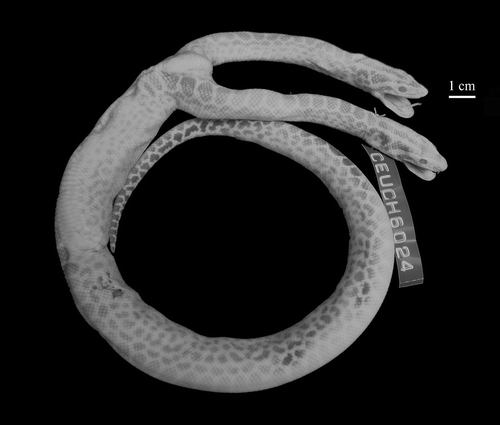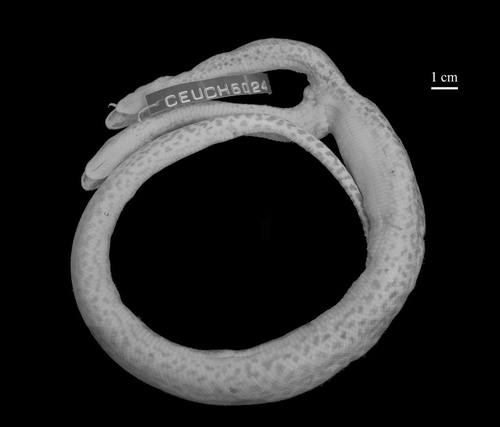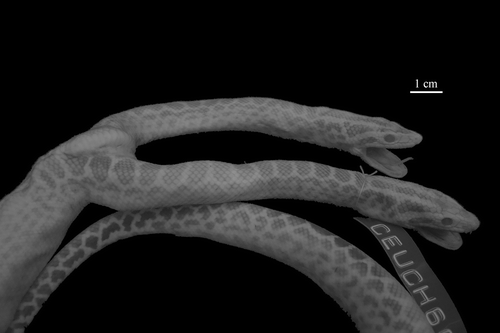Abstract
We describe a case of dicephalism in a yellow anaconda snake, Eunectes notaeus, from southern Pantanal, Brazil. The specimen exhibits two heads and two long necks, which are united on the anterior third of the body. Two hearts, three lungs, two livers, and two stomachs are also present. The left heart is larger and more cranial than the right heart although they are in the normal position. Radiographs revealed approximately 64 vertebrae in the right neck, 57 in the left neck, eight in the fusion zone, 202 in the trunk, and 52 in the tail. According to the classification adopted in the present study the specimen herein described is a proarchodichotomous specimen. This is the first record of dicephalism in Eunectes. Further, this snake represents the 28th documented case of dicephalism within the family Boidae and the 1088th case in snakes.
Introduction
Two-headed (dicephalic) animals have long been known to exist. Among squamates research has documented four cases of dicephalism in three families of lizards (Gekkonidae, Scincidae and Lacertidae) and eight families of snakes (Leptotyphlopidae, Pythonidae, Boidae, Tropidophiidae, Viperidae, Elapidae, Hydrophiidae, and Colubridae) (McAllister and Wallach Citation2006; Spadola and Insacco Citation2009). Recently, Wallach (Citation2007) provided an extensive review for 950 cases of dicephalism in snakes, including a checklist of 169 species in 93 genera and distribution of records within the families. He also summarized the internal anatomy and discussed the available information on behaviour and natural history of dicephalic snakes. According to Wallach (pers. comm.), the number of cases to date is 1087, with 171 species in 95 genera. This paper reports the first case of dicephalism in a yellow anaconda snake, Eunectes notaeus, and the first case within the genus Eunectes, with information on its external morphology, colouration, dentition and internal anatomy.
Materials and methods
The specimen is deposited in the Coleção Zoológica de Referência of the Campus do Pantanal/UFMS (CEUCH 6024). It was collected in 1985 on the right margin of Paraguay River, inside the urban area of Corumbá (19°01′00″S, 57°38′60″W, 108 m altitude), Mato Grosso do Sul state, Brazil. The specimen was sacrificed immediately after capture so we cannot make inferences about its behaviour. Ventral scales were counted according to Dowling (Citation1951). Anomalous half-ventrals were not counted and partly divided ventrals were counted as one scale. All measurements, including those of hearts, were made to the nearest 0.1 mm using a digital calliper. Snout-vent and tail length (SVL) were taken with a flexible ruler to the nearest millimetre. Head length was measured from quadrate-articular jaw joint to tip of snout, whereas snout length was measured from tip of snout to anterior margin of orbit. Bilateral variation is reported as right/left. Sex of specimen was determined by making a post-cloacal incision between the eighth and twelfth subcaudals. The number of scales and maxillary teeth of the dicephalic anaconda were compared with the known variation among normal individuals of Eunectes notaeus (see Carreira et al. [Citation2005] and references therein). The specimen was also irradiated with X-rays.
Results
Description of specimen
A young female with the following combination of characters (–): right head/left head length from snout to fusion zone 119 mm/114 mm (∼25.8% of SVL) plus 332 mm until the single anal scale. Mid-body scale rows 49, with 30 rows on posterior region of body; 36 ventrals below the right neck, 30 ventrals below the left; 186 ventrals from fusion zone to anal scale; 59 paired subcaudals. Tail length 86 mm (tail complete). Heads moderately short and distinct from necks (). Rostrals slightly wider than high, visible from above. Nasals divided; postnasals separated from preoculars by one large loreal scale on each side; loreals irregularly trapezoidal. Eyes surrounded by the following scales: one large preocular on each side, twice higher than wide; a pair of distinctive supraoculars, more than three times longer than wide (supraocular and loreal scales separated from frontal by a large scale); 3/4 postoculars, wider than high; and 2/2 suboculars. Pupils round. Frontal pentagonal, longer than wide (2.77/2.57 right head; 2.88/2.95 left head), with anterior margin contacting prefrontals. Right head length 24.10 mm, 5.6% of SVL; snout length 7.97 mm; interorbital distance 7.21 mm; supralabials 14/14, with 5–8/5–8 contacting suboculars; infralabials 18/18. Left head length 25.36 mm, 6.2% of SVL; snout length 8.21 mm; interorbital distance 6.97 mm; supralabials 14/14, with 5–9/5–9 contacting suboculars; infralabials 18/18. Dorsal scales smooth without apical pits. Anal spurs present. Body and tail stout; tail terminated by a bluntly rounded tip. Radiographs revealed approximately 64 vertebrae in the right neck, 57 in the left neck, eight in the fusion zone, 202 in the trunk (i.e. from bifurcation to cloaca), and 52 in the tail. The longest neck estimate of 64 vertebrae corresponds to 23.5% of the total body vertebrae. The following organs are duplicated: heart, lung, liver and stomach. The left heart (11.32 mm long) is larger and more cranial than the right heart (10.74 mm long) although they are in normal position. There are two cardiac lungs on the left side of the body; these form a long narrow sac starting near the left heart and are partially united for 23.83 mm. The longest of these organs is 52.41 mm. Otherwise, there is a single cardiac lung on the right side of the body, with a length of 45.24 mm. Maxillary teeth 15/15 in both heads.
Colouration
The specimen is faded, so that the original colour pattern is weak or absent. Dorsal colouration pale, upon which is a single row of 13 small brown ocelli extending from each neck until the fusion zone. These average two or three scales long and nine scales in width. A triple row of smaller, irregularly shaped ocelli lies on either side below the dorsal series. The number of ocelli from the fusion zone to the point directly above the anal scale is 50. The ocelli are continued on the tail although placed irregularly. A black postocular stripe five scales long occupies upper edges of last two supralabials in both heads. Chin and throat pale; belly pale but marked with a double row of irregular brown blotches.
Remarks
Carreira et al. (Citation2005) summarized the known variation in number of scales and maxillary teeth within Eunectes notaeus. shows the comparison between CEUCH 6024 and data from Carreira et al. (Citation2005). Despite the small number of ventrals for necks with more than 50 vertebrae, we have also noted 11 and 10 anomalous ventrals (i.e. half-ventrals or partly divided ventrals) between the ventral scales of the left and right neck, respectively. CEUCH 6024 falls within Wallach's (Citation2007) category 1 (i.e. voucher specimen deposited in a museum or private collection). The specimen described represents the twenty-eighth case of dicephalism in the family Boidae, the second dicephalic boid described for South America, the twenty-eighth dicephalous snake in Brazil (see Wallach [Citation2007] and references therein; Wallach, pers. comm.). Other dicephalic boids include Acrantophis dumerilii, Boa constrictor, Epicrates angulifer, E. cenchria, E. maurus, E. striatus, Lichanura roseofusca and Gongylophis conicus (Cunha Citation1968; Vinegar Citation1973; Hoser and Harris Citation2005; Wallach Citation2007; Wallach, pers. comm.). Smith and Pérez-Higareda (Citation1987) classified dicephalic snake specimens into seven categories. According to their classification, CEUCH 6024 is a proarchodichotomous specimen. Specimens falling into this category have two heads, two long necks, and a single body and tail.
Table 1. Comparison of number of scales and maxillary teeth of CEUCH 6024 with the known variation in normal individuals of Eunectes notaeus (see Carreira et al. [Citation2005] and references therein)
Acknowledgements
We wish to thank Antônio Glauter Ferreira and Iria Hiromi Ishii for their assistance in providing us with the data for the CEUCH specimen. NA owe particular thanks to Gecele Paggi for her support and encouragement during the writing of this manuscript. The radiographs were kindly provided by Carlos Sahib. Van Wallach and one anonymous reviewer offered suggestions that greatly improved the manuscript. Further, Van Wallach kindly shared with NA his unpublished data on dicephalic snakes.
References
- Carreira , S , Meneghel , M and Achaval , F . 2005 . Reptiles de Uruguay , Montevideo (Uruguay) : Universidad de la República, Facultad de Ciencias .
- Cunha , OR . 1968 . Um teratódimo deródimo em jibóia (Constrictor constrictor constrictor [Linn., 1766]) (Ophidia; Boidae) . Bol Mus Para Emilio Goeldi , 67 ( 123 ) : 1 – 17 .
- Dowling , HG . 1951 . A proposed standard system of counting ventrals in snakes . Br J Herpetol , 5 ( 1 ) : 97 – 99 .
- Hoser , RT and Harris , P . 2005 . A second case of bicephalism in Queensland carpet snakes (Morelia spilota mcdowelli) (Serpentes: Pythonidae) . Herpetofauna , 35 ( 1 ) : 61
- Mcallister , CT and Wallach , V . 2006 . Discovery of a dicephalic western diamondback rattlesnake, Crotalus atrox (Serpentes: Viperidae), from Texas, with a summary of dicephalism among members of the genus Crotalus . J Ark Acad Sci. , 60 : 67 – 73 .
- Smith , HM and Pérez-Higareda , G . 1987 . The literature on somatodichotomy in snakes . Bull Md Herpetol Soc. , 23 ( 4 ) : 139 – 153 .
- Spadola , F and Insacco , G . 2009 . Newborn dicephalic Podarcis sicula . Acta Herpetol. , 4 ( 1 ) : 99 – 101 .
- Vinegar , A . 1973 . The effects of temperature on the growth and development of embryos of the Indian python, Python molurus (Reptilia: Serpentes: Boidae) . Copeia , 1973 ( 1 ) : 171 – 173 .
- Wallach , V . 2007 . Axial bifurcation and duplication in snakes. Part I. A synopsis of authentic and anecdotal cases . Bull Md Herpetol Soc. , 43 ( 2 ) : 57 – 95 .


